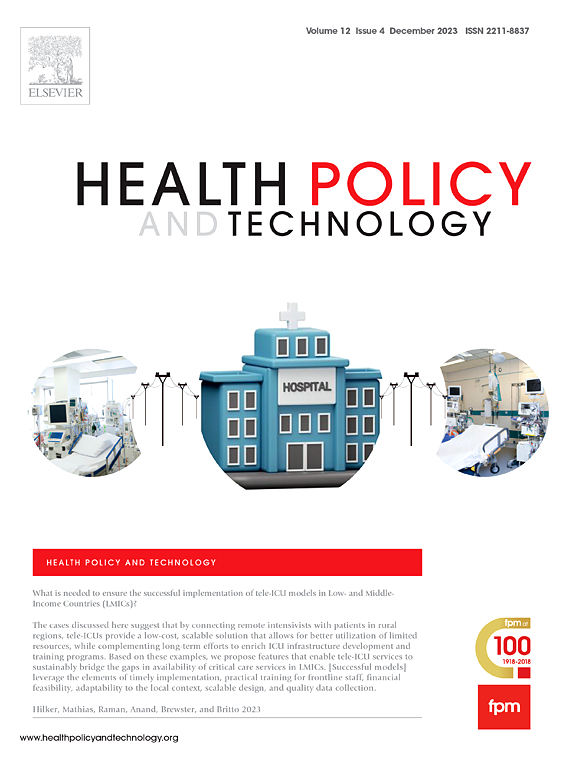The economic value of virtual primary healthcare services for rural populations: A systematic review
IF 3.7
3区 医学
Q1 HEALTH POLICY & SERVICES
引用次数: 0
Abstract
Background
Virtual healthcare services are increasingly overcoming geographical barriers and improving access to primary healthcare, especially for rural populations. This systematic review evaluates the economic value of virtual healthcare interventions in rural primary healthcare settings.
Methods
A systematic review was conducted following the Preferred Reporting Items for Systematic Reviews and Meta-analyses Protocol guidelines. The search strategy included databases such as MEDLINE, PubMed, CINAHL, PsycINFO, and ECOLIT, covering studies published between January 31, 2010, and January 31, 2024. The quality of included studies was assessed using the Consolidated Health Economic Evaluation Reporting Standards (CHEERS) 2022 checklist.
Results
Fifteen studies met inclusion criteria. Studies were classified into cost–benefit analyses (n = 2), cost analysis (n = 4), and cost-effectiveness/cost-utility (n = 9) studies. Five studies met over 70 % of CHEERS 2022 reporting criteria. Key findings include significant cost savings and improved cost-effectiveness for interventions targeting elderly populations, Indigenous populations, war veterans, and adults in general.
Discussion
The review highlights the economic value of virtual healthcare in rural primary healthcare settings, derived from cost savings and cost-effective service provision. However, inconsistencies in defining ‘virtual healthcare’, limited stakeholder engagement, and incomplete reporting of economic outcomes were identified. Future research should further consider the long-term sustainability, inclusion of younger populations, and wider stakeholder consultation in economic evaluations.
Conclusion
Virtual healthcare is a cost-effective and sustainable solution for strengthening rural primary healthcare systems. Policymakers and healthcare providers are encouraged to scale up rural virtual healthcare models to bridge healthcare disparities and enhance equity in access to healthcare in rural settings.
Public Interest Summary
This systematic review critically examined the economic value of virtual healthcare interventions within rural primary healthcare settings. Synthesis of evidence reveals the substantial cost savings and cost-effectiveness of rural virtual healthcare services, particularly for interventions targeting older adults, Indigenous communities, war veterans, and the general adult population.
The findings underscore the major economic advantages of integrating virtual healthcare into rural primary care services. However, it also highlights limitations, such as inconsistent definitions for ‘virtual healthcare’, insufficient engagement with diverse stakeholders, and incomplete reporting of economic outcomes. Future research should prioritise long-term sustainability, include younger populations, and conduct rigorous cross-jurisdictional economic evaluations.
Virtual healthcare presents a promising avenue for strengthening rural primary healthcare by offering a cost-effective and accessible solution addressing healthcare disparities. We encourage policymakers and healthcare providers to consider strategic scaling of evidence-based rural virtual healthcare models to improve equity in access to essential healthcare for geographically dispersed populations.
农村人口虚拟初级卫生保健服务的经济价值:系统综述
虚拟卫生保健服务正日益克服地理障碍,改善获得初级卫生保健的机会,特别是对农村人口而言。本系统综述评估了虚拟卫生保健干预在农村初级卫生保健设置的经济价值。方法按照系统评价和荟萃分析方案指南的首选报告项目进行系统评价。搜索策略包括MEDLINE、PubMed、CINAHL、PsycINFO和ECOLIT等数据库,涵盖了2010年1月31日至2024年1月31日之间发表的研究。纳入研究的质量采用综合健康经济评价报告标准(CHEERS) 2022检查表进行评估。结果15项研究符合纳入标准。研究分为成本效益分析(n = 2)、成本分析(n = 4)和成本-效果/成本-效用(n = 9)研究。5项研究达到了干杯2022报告标准的70%以上。主要发现包括针对老年人、土著居民、退伍军人和一般成年人的干预措施显著节省了成本,提高了成本效益。该综述强调了虚拟医疗在农村初级卫生保健机构的经济价值,源于成本节约和具有成本效益的服务提供。然而,确定了在定义“虚拟医疗”方面的不一致,利益相关者参与有限,以及经济成果报告不完整。未来的研究应进一步考虑经济评估的长期可持续性、年轻人口的包容性和更广泛的利益相关者咨询。结论虚拟医疗是加强农村初级卫生保健体系的一种经济、可持续的解决方案。鼓励政策制定者和卫生保健提供者扩大农村虚拟卫生保健模式,以弥合卫生保健差距,增强农村环境中获得卫生保健的公平性。这篇系统综述批判性地考察了农村初级卫生保健设置中虚拟卫生保健干预的经济价值。综合证据表明,农村虚拟医疗保健服务节省了大量成本并具有成本效益,特别是针对老年人、土著社区、退伍军人和一般成年人的干预措施。研究结果强调了将虚拟医疗纳入农村初级保健服务的主要经济优势。然而,它也强调了局限性,例如“虚拟医疗”的定义不一致,与不同利益相关者的接触不足,以及对经济成果的报告不完整。未来的研究应优先考虑长期可持续性,包括年轻人口,并进行严格的跨司法管辖区经济评估。虚拟医疗为加强农村初级卫生保健提供了一条很有希望的途径,它提供了一种具有成本效益和可获得的解决方案,解决了卫生保健差距问题。我们鼓励政策制定者和医疗服务提供者考虑战略性地扩大基于证据的农村虚拟医疗模式,以提高地理分散人群获得基本医疗服务的公平性。
本文章由计算机程序翻译,如有差异,请以英文原文为准。
求助全文
约1分钟内获得全文
求助全文
来源期刊

Health Policy and Technology
Medicine-Health Policy
CiteScore
9.20
自引率
3.30%
发文量
78
审稿时长
88 days
期刊介绍:
Health Policy and Technology (HPT), is the official journal of the Fellowship of Postgraduate Medicine (FPM), a cross-disciplinary journal, which focuses on past, present and future health policy and the role of technology in clinical and non-clinical national and international health environments.
HPT provides a further excellent way for the FPM to continue to make important national and international contributions to development of policy and practice within medicine and related disciplines. The aim of HPT is to publish relevant, timely and accessible articles and commentaries to support policy-makers, health professionals, health technology providers, patient groups and academia interested in health policy and technology.
Topics covered by HPT will include:
- Health technology, including drug discovery, diagnostics, medicines, devices, therapeutic delivery and eHealth systems
- Cross-national comparisons on health policy using evidence-based approaches
- National studies on health policy to determine the outcomes of technology-driven initiatives
- Cross-border eHealth including health tourism
- The digital divide in mobility, access and affordability of healthcare
- Health technology assessment (HTA) methods and tools for evaluating the effectiveness of clinical and non-clinical health technologies
- Health and eHealth indicators and benchmarks (measure/metrics) for understanding the adoption and diffusion of health technologies
- Health and eHealth models and frameworks to support policy-makers and other stakeholders in decision-making
- Stakeholder engagement with health technologies (clinical and patient/citizen buy-in)
- Regulation and health economics
 求助内容:
求助内容: 应助结果提醒方式:
应助结果提醒方式:


